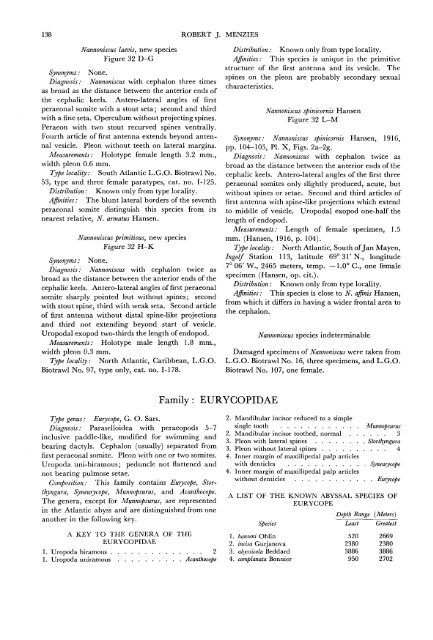The Isopods of Abyssal Depths in the Atlantic Ocean
The Isopods of Abyssal Depths in the Atlantic Ocean
The Isopods of Abyssal Depths in the Atlantic Ocean
You also want an ePaper? Increase the reach of your titles
YUMPU automatically turns print PDFs into web optimized ePapers that Google loves.
138 ROBERT J. MENZIES<br />
Nannoniscus laevis, new species<br />
Figure 32 D-G<br />
Synonyms: None.<br />
Diagnosis: Nannoniscus with cephalon three times<br />
as broad as <strong>the</strong> distance between <strong>the</strong> anterior ends <strong>of</strong><br />
<strong>the</strong> cephalic keels. Antero-lateral angles <strong>of</strong> first<br />
peraeonal somite with a stout seta; second and third<br />
with a f<strong>in</strong>e seta. Operculum without project<strong>in</strong>g sp<strong>in</strong>es.<br />
Peraeon with two stout recurved sp<strong>in</strong>es ventrally.<br />
Fourth article <strong>of</strong> first antenna extends beyond antennal<br />
vesicle. Pleon without teeth on lateral marg<strong>in</strong>s.<br />
Measurements: Holotype female length 3.2 mm.,<br />
width pleon 0.6 mm.<br />
Type locality: South <strong>Atlantic</strong> L.G.O. Biotrawl No.<br />
53, type and three female paratypes, cat. no. 1-125.<br />
Distribution: Known only from type locality.<br />
Aff<strong>in</strong>ities: <strong>The</strong> blunt lateral borders <strong>of</strong> <strong>the</strong> seventh<br />
peraeonal somite dist<strong>in</strong>guish this species from its<br />
nearest relative, N. armatus Hansen.<br />
Nannoniscus primitivus, new species<br />
Figure 32 H-K<br />
Synonyms: None.<br />
Diagnosis: Nannoniscus with cephalon twice as<br />
broad as <strong>the</strong> distance between <strong>the</strong> anterior ends <strong>of</strong> <strong>the</strong><br />
cephalic keels. Antero-lateral angles <strong>of</strong> first peraeonal<br />
somite sharply po<strong>in</strong>ted but without sp<strong>in</strong>es; second<br />
with stout sp<strong>in</strong>e, third with weak seta. Second article<br />
<strong>of</strong> first antenna without distal sp<strong>in</strong>e-like projections<br />
and third not extend<strong>in</strong>g beyond start <strong>of</strong> vesicle.<br />
Uropodal exopod two-thirds <strong>the</strong> length <strong>of</strong> endopod.<br />
Measurements: Holotype male length 1.8 mm.,<br />
width pleon 0.3 mm.<br />
Type locality: North <strong>Atlantic</strong>, Caribbean, L.G.O.<br />
Biotrawl No. 97, type only, cat. no. 1-178.<br />
Type genus: Eurycope, G. O. Sars.<br />
Diagnosis: Paraselloidea with peraeopods 5-7<br />
<strong>in</strong>clusive paddle-like, modified for swimm<strong>in</strong>g and<br />
bear<strong>in</strong>g dactyls. Cephalon (usually) separated from<br />
first peraeonal somite. Pleon with one or two somites.<br />
Uropoda uni-biramous; peduncle not flattened and<br />
not bear<strong>in</strong>g pulmose setae.<br />
Composition: This family conta<strong>in</strong>s Eurycope, Storthyngura,<br />
Syneurycope, Munnopsurus, and Acanthocope.<br />
<strong>The</strong> genera, except for Munnopsurus, are represented<br />
<strong>in</strong> <strong>the</strong> <strong>Atlantic</strong> abyss and are dist<strong>in</strong>guished from one<br />
ano<strong>the</strong>r <strong>in</strong> <strong>the</strong> follow<strong>in</strong>g key.<br />
A KEY TO THE GENERA OF THE<br />
EURYCOPIDAE<br />
1. Uropoda biramous 2<br />
1. Uropoda uniramous Acanthocope<br />
Family: EURYCOPIDAE<br />
Distribution: Known only from type locality.<br />
Aff<strong>in</strong>ities: This species is unique <strong>in</strong> <strong>the</strong> primitive<br />
structure <strong>of</strong> <strong>the</strong> first antenna and its vesicle. <strong>The</strong><br />
sp<strong>in</strong>es on <strong>the</strong> pleon are probably secondary sexual<br />
characteristics.<br />
Nannoniscus sp<strong>in</strong>icornis Hansen<br />
Figure 32 L-M<br />
Synonyms: Nannoniscus sp<strong>in</strong>icornis Hansen, 1916,<br />
pp. 104-105, PI. X, Figs. 2a-2g.<br />
Diagnosis: Nannoniscus with cephalon twice as<br />
broad as <strong>the</strong> distance between <strong>the</strong> anterior ends <strong>of</strong> <strong>the</strong><br />
cephalic keels. Antero-lateral angles <strong>of</strong> <strong>the</strong> first three<br />
peraeonal somites only slightly produced, acute, but<br />
without sp<strong>in</strong>es or setae. Second and third articles <strong>of</strong><br />
first antenna with sp<strong>in</strong>e-like projections which extend<br />
to middle <strong>of</strong> vesicle. Uropodal exopod one-half <strong>the</strong><br />
length <strong>of</strong> endopod.<br />
Measurements: Length <strong>of</strong> female specimen, 1.5<br />
mm. (Hansen, 1916, p. 104).<br />
Type locality: North <strong>Atlantic</strong>, South <strong>of</strong> Jan Ma yen,<br />
Ingolf Station 113, latitude 69° 31'N., longitude<br />
7° 06' W., 2465 meters, temp. —1.0° C, one female<br />
specimen (Hansen, op. cit.).<br />
Distribution: Known only from type locality.<br />
Aff<strong>in</strong>ities: This species is close to N. aff<strong>in</strong>is Hansen,<br />
from which it differs <strong>in</strong> hav<strong>in</strong>g a wider frontal area to<br />
<strong>the</strong> cephalon.<br />
Nannoniscus species <strong>in</strong>determ<strong>in</strong>able<br />
Damaged specimens <strong>of</strong> Nannoniscus were taken from<br />
L.G.O. Biotrawl No. 16, three specimens, and L.G.O.<br />
Biotrawl No. 107, one female.<br />
2. Mandibular <strong>in</strong>cisor reduced to a simple<br />
s<strong>in</strong>gle tooth Munnopsurus<br />
2. Mandibular <strong>in</strong>cisor too<strong>the</strong>d, normal 3<br />
3. Pleon with lateral sp<strong>in</strong>es Storthyngura<br />
3. Pleon without lateral sp<strong>in</strong>es 4<br />
4. Inner marg<strong>in</strong> <strong>of</strong> maxillipedal palp articles<br />
with denticles Syneurycope<br />
4. Inner marg<strong>in</strong> <strong>of</strong> maxillipedal palp articles<br />
without denticles Eurycope<br />
A LIST OF THE KNOWN ABYSSAL SPECIES OF<br />
EURYCOPE<br />
Depth Range (Meters)<br />
Species Least Greatest<br />
1. hanseni Ohl<strong>in</strong> 520 2669<br />
2. <strong>in</strong>cisa Gurjanova 2380 2380<br />
3. abyssicola Beddard 3886 3886<br />
4. complanata Bonnier 950 2702

















